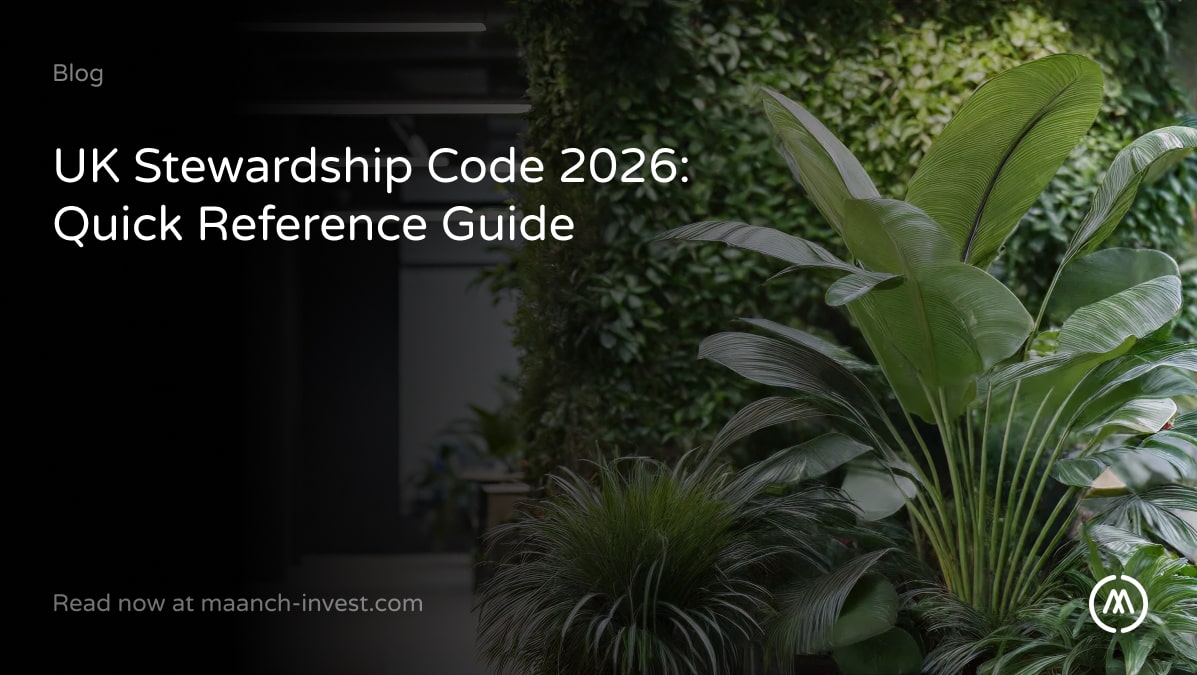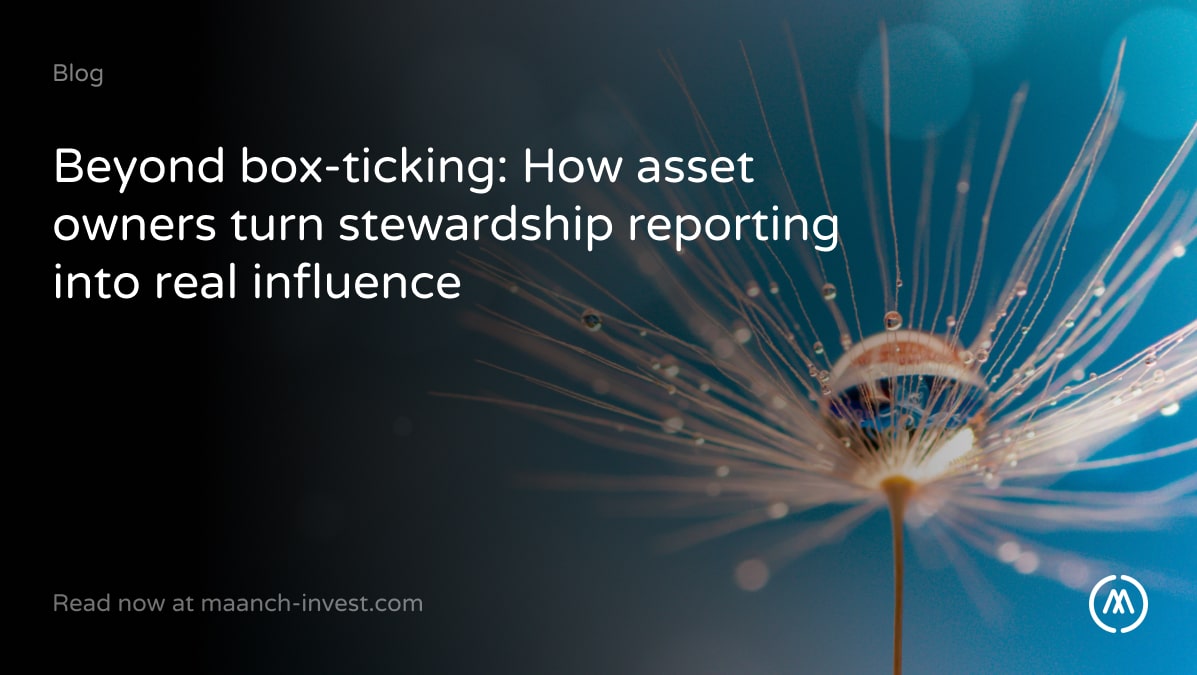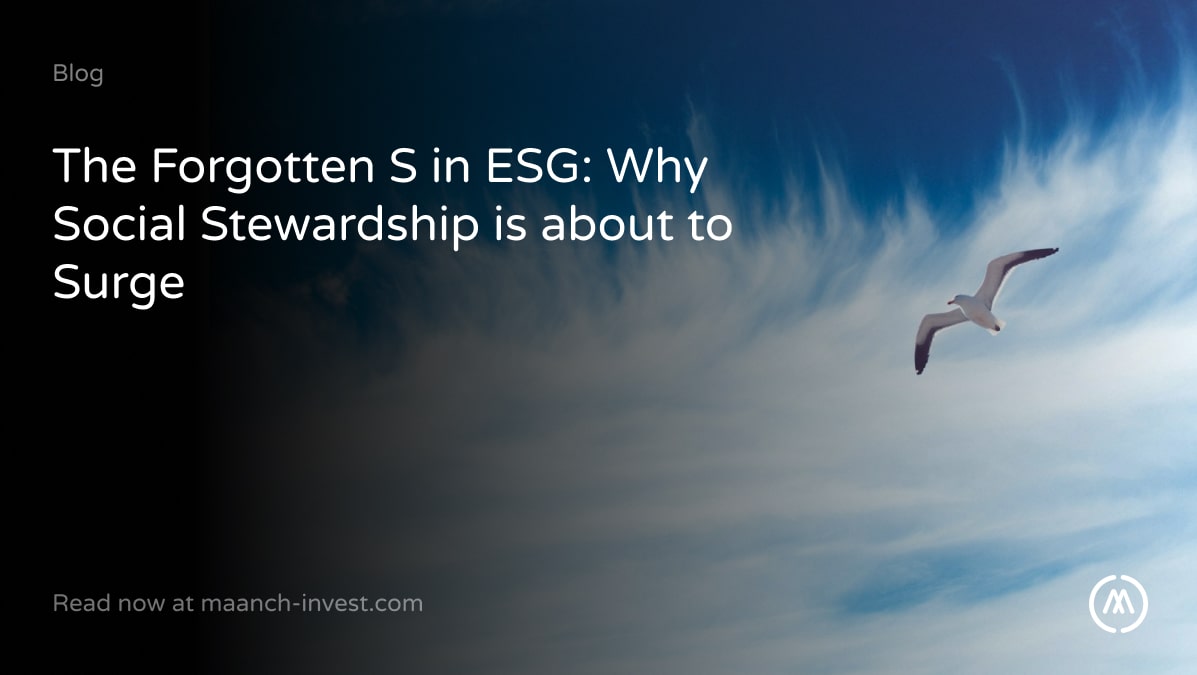A Conversation with Sally Bridgeland
Today is our first of many blogs in this new interview series Maanch is carrying out with experts in the ESG space. We are happy to welcome Sally Bridgeland, an ESG veteran who has extensive experience in risk management, particularly across the pension industry for over 30 years. Sally is currently working in a number of non-executive and advisory roles, including Chair of Impax Asset Management Group.
Our interviewer is Vidhisha Masrani, Marketing Director at Maanch. Together, Sally and Vidhisha had a fruitful and productive conversation on the challenges, opportunities and trends of ESG engagement in Asset Management.
Trends in ESG engagement
1. What is ESG engagement? How would you define it if you had to explain it to someone outside the asset management industry?
Engagement is all about the kinds of dialogue investors have with the companies they’re investing in.
ESG focuses on more than just the financial results of a company in which you are invested – it specifically requires investment managers to consider environmental, social and governance issues around a company.
2. How should investors engage with companies in relation to ESG? What are your top 3 tips?
The first tip I would give is only to engage on something when you know what you’ll do as a result of the engagement. As investors, you should have an endpoint in mind that would lead you to be very clear about your objectives and boundaries: when would you divest?
My second tip would be to only engage on the thing you know something about. You’re dealing with companies who have got a particular point of view. From my experience, companies are more likely to listen to you if you have something intelligent to say on the topic.
My final tip is to collaborate. Find out what other investors are doing and embrace collaboration – and that’s one of the UN Principles of Responsible Investment. Grouping together with like-minded investors can make your voice more effective, as well as more informed.
3. What are the most noticeable changes in ESG stewardship and engagement in the last five years?
The UK pension fund regulations changed three or four years ago, which meant that climate change was included in the issues which trustees had to consider in their Statement of Investment Principles as having a financial impact on investments. That was the first time pension fund trustees, their advisors and asset managers were required to have a view on climate change.
We also had COP26 last year which added political pressure to do more on climate change. People have moved from “well I’m a believer or not a believer on climate change” to “if I don’t do anything at all, there will be a negative impact”.
Another big change I’ve noticed is the demand for data beyond financial metrics. Carbon disclosure, diversity and executive pay are examples of other metrics.
4. How do you see the role of engagement within responsible investment and ESG changing in the next five years? Moreover, are there any trends you’re seeing with ESG engagement that are emerging at the moment?
There are a couple of areas where the conversation is early: it’s rather like active and passive investments. The passive approach is to use ESG data to tilt the index or exclude stocks to avoid the bad stuff and raise the game that way, whereas the active approach is to think ahead about innovative solutions we need to see in the future.
The debate about whether it’s better to exclude bad investments or engage with them is still emerging. A good example is BP deciding to move out of Russia – the problem is who will buy those assets and will they be a better steward than BP?
Another conversation that’s still emerging is on what we are engaging about. There are numerous issues out there which need to be tackled for a sustainable future, including an issue I’m passionate about – improving the quality of life for the elderly. Whatever the issue, the “S” in ESG is emerging, showing that you care about people’s well-being in the present and future to move the needle forward.
5. Can you give an example of ESG engagement? If so, what opportunities does an effective engagement policy bring to improve ESG engagement overall?
My advice for an effective engagement policy is to not try to push water uphill. Instead, find an issue where the water is going downhill. That way, a nudge will make a bigger difference.
On the governance side, I’ve seen progress in getting more women on boards. Active engagement reveals which corporate boards are behind the curve – and corporate boards don’t like being laggards. This is an example where data can reduce poor behaviour.
Innovation in climate change is another current issue where there’s a thirst for innovation and where opportunities lie for long-term investors. Take the market leader in renewable and recycling technology, Tomra. When their Chief Executive came to our Impax’s 20th birthday party a couple of years ago, he said that engaging in a supportive dialogue with investors helped Tomra be braver at being innovative in developing better technologies which would take time to develop. That type of active engagement is so important for innovative companies seeking long-term partnerships with their investors.
It’s similar to parenting: one school of thought is that your child responds best to being told when they’re doing the wrong thing. The other way -which I prefer – is to encourage good behaviour. It’s handy to remind yourself of the saying ‘praise is magic’ because you’re more likely in the long run to have a more enduring, constructive relationship with the person making the decisions at the company.
6. How does ESG Engagement create value for investors and companies?
The easiest value to point to is the idea of avoiding risks – this can be done by having conversations about what’s behind the finance for both parties involved.
You don’t have to be an actuary (and I am one) to realise that if you lose half the value of your investments (50% down), you have to get a return of 100% to get back up to the same point again. This is just how compound interest works. Avoiding negative shocks is key in financial terms.
It’s human psychology that when individuals on a company’s board know they are being watched, they are more likely to make risk-aware decisions. When investors engage by writing a
letter, this evidences their interest and shows that they are watching. The danger is that some companies won’t be brave enough to make changes or provide solutions. That’s where active, constructive engagement comes in to support management.
7. In your view, how can ESG engagement boost corporate sustainability?
Creating a peer group where investors can look at their portfolio on a range of metrics can boost corporate sustainability. It’s human nature to continually raise the bar when there’s competition.
For example, on environmental factors, you could look at what a company’s net zero targets are. On social factors, investors could see what a company’s workforce looks like. On governance factors, it’s vital to board composition and know how a company drives forward ESG issues: for example, through an ESG committee. All of these points help move the non-financial issues higher up on the board’s agenda.
8. Is there an ESG engagement strategy? A guideline that asset managers and investors can follow?
One of the challenges is that there are a lot of choices considering the diverse strategies and guidelines out there which cover particular issues.
My approach is to start bottom-up. Focus on what matters to you, what you’re good at and what you’re passionate about. Something I’ve learnt from most of my career as a senior executive is you have to decide on the things that aren’t going to move the dial versus the things that will. This approach also helps to attract the right support and resources so you can engage expertly on the things which you care about.
I’ve also seen a lot of greenwashing in the last five years on ESG. One company may be greenwashing and another isn’t, but when you read their reports you can’t spot the difference. Good ESG engagement should help you tell the difference because of the specific data points which back up the claims and examples that the company is proud of.
The glorious thing about asset management is that by being clear about your passions and expertise, it makes the relationship more sticky between investors, investment managers and the companies in which they invest because they value the same things.
Technology & ESG engagement
1. How is technology currently used in the ESG engagement space, if at all?
Back in 2003 when the phrase “responsible investment” was first used, people were starting to have conversations about the need for data. Now, I think the data is still emerging. While I see the great ideas being developed, including solutions here at Maanch, I haven’t seen anything that has a ‘knock your socks off’ appeal because different users need different things.
These engagement tracking tools tend to be built by people using them. So while the technology is impressive and creates opportunities, it’s still hard for ordinary people to use them.
2. How is engagement data currently captured and managed? Is there an ESG data management software that you use or have heard of?
I sense that it’s probably being managed using customer relationship management (CRM) databases to keep track of contact points and conversations.
The challenge is rather than recording the data, CRM databases are tracking actions which aren’t integrated as different individuals are tracking actions, transactions and impacts.
3. How can the introduction of ESG SaaS streamline the engagement processes for asset managers and other institutional investors?
The reason why we haven’t invested more in this technology is that ESG has been seen as an overhead rather than an added value part of the investment process. It’s only now that the industry is seeing an increased client demand, particularly on the environmental and climate change issues because of regulations and political pressure.
The cost is now higher to respond to these issues than it was before because of the complexity of the data and reporting. It’s therefore easier to justify expenditure on anything that makes the cost more efficient. You can’t engage with a team of just two people anymore, and the more people involved in the engagement process, the steps to save time are worth more and help maintain consistent valuable data.
4. Do you think ESG engagement tracking tools can help navigate complex measurement frameworks and optimise reporting and compliance? If so, then how?
Part of the challenge is knowing who the right customer is that you want to target: is it the custodians, asset managers, investment consultants or end clients? All of these customers have different needs. Some big pension funds example manage their assets by themselves while others outsource them. At the moment I think the challenge is that the allocation of roles is all a bit fluid. A longer-term vision is needed to drive the right sort of collaboration to solve problems right now.
In local authority pools for example, it might make sense to gather the data across several pools because then you would have better economies of scale for client reporting. That’s why innovation is hard – you need a picture of the future that appeals to a critical mass of clients while carrying on servicing clients using old technology.
5. What obstacles do you see in terms of implementing such a solution?
Such a solution will involve a lot of people. There will be technology siloes, including the user perspective and the client servicing perspective. Getting all those people lined up on one agenda is the biggest challenge. Everyone has their own way of doing things and there is an obstacle of inertia.
What might save time for someone will also take time for someone else to implement. The fact is that it’s not always the person benefitting that has to put the effort in. A technology expert swamped in cybersecurity tasks wants to know what’s in it for them when you ask for a new ESG engagement tool. To the technology expert, it’s just another task – so selling it to the end user is only the first step in an organisation.



